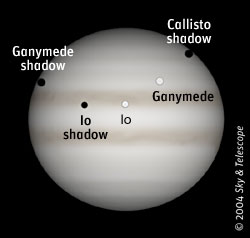
This illustration shows the locations of three moon shadows (plus two moons) on Jupiter's disk at approximately 3:10 a.m. Eastern Standard Time on March 28, 2004. North is up.
Sky & Telescope illustration.
This coming weekend, weather permitting, almost anyone with a telescope in North America (and northwestern South America) can see the shadows of three moons on Jupiter's disk at once. On Sunday morning, March 28, 2004, the shadows of Callisto and Io are already crossing Jupiter's disk when, at 8:00 Universal Time, they are joined by the shadow of Ganymede. Nineteen minutes later, at 8:19 UT, Callisto's shadow moves off the disk, bringing this rare triple shadow transit to a close.
The event starts at 3:00 a.m. EST Sunday morning in eastern North America, with Jupiter fairly low in the western sky. The planet is much higher up for those on the West Coast, where it starts at 12:00 a.m. PST (that is, midnight Saturday evening).
Throughout the 19-minute period only Callisto will be easy to see, just west of Jupiter. Io and Ganymede (with their shadows) will be crossing in front of the disk and thus hard to discern in telescopes. Europa will be out of sight behind the planet. To display Jupiter's moons on any date and time, see the JavaScript utility in "Chasing the Moons of Jupiter."
The March 28th event is a marvelous opportunity for those doing telescopic imaging with a webcam, a technology that barely existed for the last triple shadow transit on November 11, 1997. One of the few photographs ever taken of such an event is that by English amateur Horace E. Dall on April 21, 1956 (see the October 1986 Sky & Telescope, page 411).
How Rare?
Belgian amateur astronomer Christian Steyaert, writing in 1979, was the first person to call attention to the March 28, 2004, event. He also found 31 other triple shadow transits during the years 1900 to 2100. For the 1997 book Mathematical Astronomy Morsels (available from Shop at Sky), Jean Meeus recomputed these events from scratch and confirmed that the next one will take place on October 12, 2013, when European observers are favored.
Meeus points out that Jupiter's four Galilean satellites return to almost exactly the same positions relative to the Sun and Jupiter every 2,501 weeks plus a half day. So the upcoming event belongs to the same "series" as that photographed by Dall nearly 48 years ago.
 0
0
Comments
You must be logged in to post a comment.